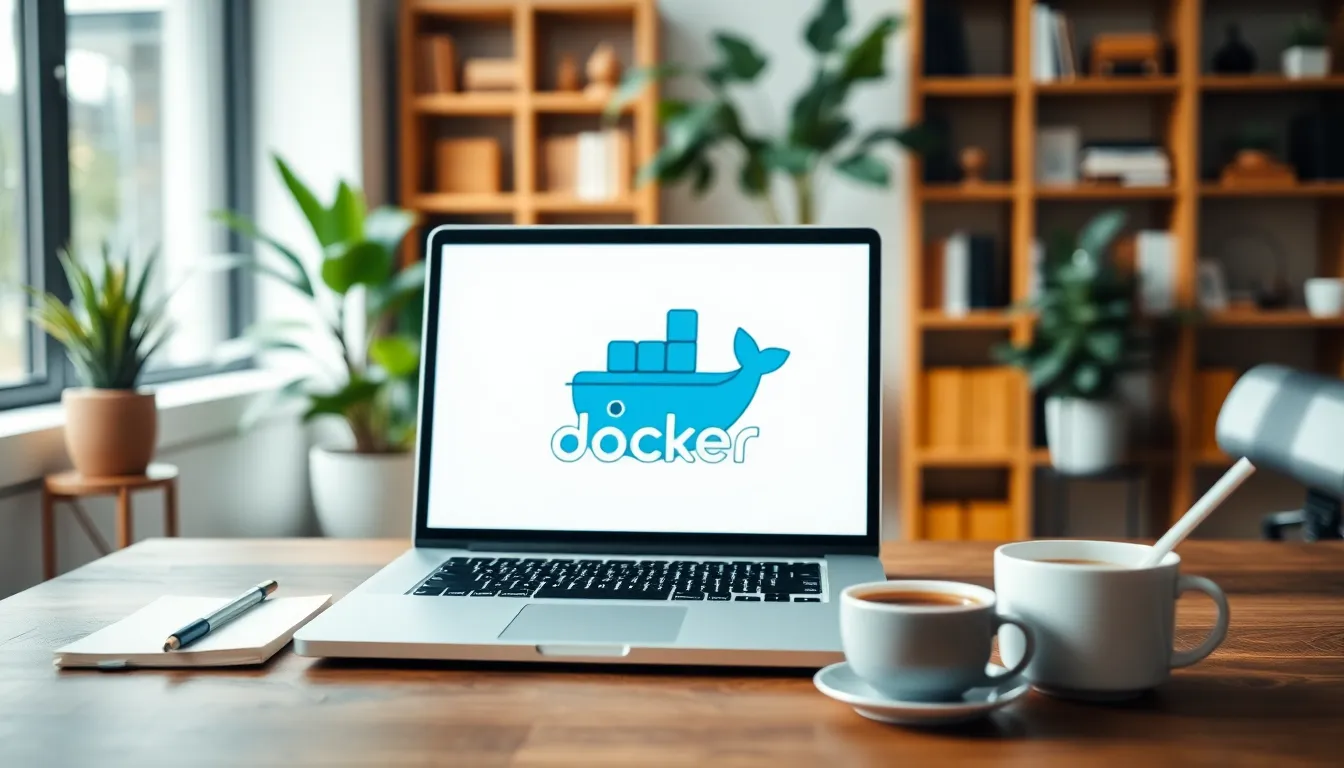Table of Contents
ToggleIn a world where software development can feel like herding cats, containerization with Docker swoops in like a superhero. Imagine packaging your applications into neat little boxes that can run anywhere without a hitch. No more “it works on my machine” excuses—Docker makes sure your code is as portable as your favorite coffee mug.
Overview of Containerization
Containerization streamlines software development by isolating applications within containers. This approach enhances portability and consistency across various environments.
What is Containerization?
Containerization is a method that encapsulates an application and its dependencies into a single, lightweight unit called a container. Each container operates independently, enabling rapid deployment and easy scaling. Developers can package applications with the necessary libraries and configurations, ensuring uniform functionality in any environment. Unlike traditional virtual machines, containers share the host operating system, which reduces overhead and improves efficiency.
Benefits of Containerization
Numerous advantages accompany containerization, making it a popular choice for developers. Cost-effectiveness stems from resource optimization, as containers require less memory and storage compared to virtual machines. Portability allows containers to run smoothly on any system that supports Docker, facilitating seamless transitions between development, testing, and production. Enhanced security is achievable, as containers offer processes isolation and minimized surface areas for potential attacks. Furthermore, rapid deployment enables swift updates and rollbacks, improving overall productivity.
Introduction to Docker

Docker addresses software development challenges, particularly code portability. Developers package applications into containers, enabling seamless execution across diverse environments.
What is Docker?
Docker is an open-source platform designed for automating the deployment of applications. It uses containerization technology to encapsulate software and its dependencies into isolated units. This approach streamlines development processes, building consistent environments that replicate easily across different stages. Docker enables developers to share applications effortlessly, ensuring that they run reliably on any system.
Key Features of Docker
Docker offers numerous features that enhance application deployment. First, it allows for lightweight containers, which share the host operating system, reducing resource consumption. Second, version control is integral, as each Docker image can be saved, tagged, and shared with ease. Third, the portability of containers means applications work uniformly across various platforms. Fourth, Docker Compose simplifies multi-container applications, making orchestration straightforward. Lastly, the active community fosters collaboration, resulting in continuous improvements and a wealth of shared knowledge.
Setting Up Docker
Setting up Docker is straightforward and ensures a seamless environment for application development. Follow these steps to get started effectively.
Installation Steps
- Visit the Docker website to download Docker Desktop for your operating system.
- Open the installer after download and follow the prompts to complete the installation process.
- After installation, launch Docker Desktop and ensure its engine starts running correctly.
- Confirm installation by opening a terminal or command prompt, then entering
docker --version. This command displays the Docker version if installation is successful.
Basic Configuration
Configuring Docker is essential for optimal performance. First, configure resource settings by accessing Docker Desktop preferences. Allocate CPU and memory based on your application’s requirements. Set up shared drives to allow containers access to files on the host system. Network settings might require adjustments for specific use cases, enabling container communication. Testing the setup can enhance assurance; running a simple docker run hello-world command ensures everything operates as expected.
Working with Docker Containers
Docker simplifies application deployment through its containerization technology. Developers can create, manage, and run containers seamlessly across environments.
Creating and Managing Containers
Creating a Docker container requires a simple command. Developers utilize docker create to set up a container from a specified image. Once created, running the container involves the docker run command, which launches it in an isolated environment. Managing containers becomes straightforward with commands like docker stop, which halts a running container, and docker rm, which removes a stopped container. Monitoring container status is essential and can be done using docker ps, which lists active containers. Understanding these commands allows developers to maintain an efficient workflow.
Networking in Docker
Networking plays a crucial role in containerized applications. Docker provides various networking options to enable communication between containers. By default, containers run in an isolated network, but developers can connect them using bridge networks for inter-container communication. Creating custom networks enhances flexibility and organization. The docker network create command establishes a new network, while docker network connect links existing containers to this network. Understanding these networking features empowers developers to build robust, interconnected applications.
Advanced Docker Features
Advanced Docker features enhance application management and deployment efficiency. Two notable aspects include Docker Compose and Docker Swarm.
Docker Compose
Docker Compose simplifies managing multi-container applications. Developers define services, networks, and volumes in a single docker-compose.yml file. This definition clarifies dependencies and configuration settings, enabling the deployment of an entire stack with a single command. By using docker-compose up, users can start all defined services simultaneously, streamlining the development workflow. Furthermore, it allows for easy scaling, as developers can adjust the number of container instances for specific services with the scale option. Overall, Docker Compose significantly improves the ease of working with complex applications.
Docker Swarm and Orchestration
Docker Swarm provides a robust solution for container orchestration. It allows developers to cluster multiple Docker hosts into a single virtual host, enabling seamless scaling and management of containers. Nodes in a swarm can be added or removed based on resource availability and demand. The Swarm mode includes load balancing, assisting in distributing incoming traffic across services. Additionally, it supports automatic failover, ensuring high availability of applications. Utilizing Docker Swarm, development teams can efficiently manage deployments across clusters, enhancing reliability and performance.
Real-World Applications of Docker
Docker has transformed various industries through its containerization capabilities, enabling businesses to enhance operational efficiency. This technology supports a variety of practical applications across diverse sectors.
Case Studies
Companies like Spotify utilize Docker for streamlining microservices architecture, allowing teams to deploy services independently. eBay leverages Docker for enhancing its development pipeline, enabling rapid testing and iterations. With Docker, PayPal improves its application scalability and reliability. These examples highlight the effectiveness of containerization in real-world environments and showcase its impact on accelerating deployment cycles and fostering innovation.
Industry Use Cases
The healthcare industry benefits from Docker by maintaining patient data privacy and security. Financial institutions employ Docker for secure transactions and efficient regulatory compliance, ensuring timely service delivery. E-commerce platforms like Shopify adopt Docker to manage traffic spikes during peak sales periods, enhancing stability and performance. Media companies utilize Docker to streamline content delivery, providing a seamless user experience. Each use case demonstrates how Docker adapts to specific sector needs, driving efficiency and growth.
Best Practices for Containerization with Docker
Implementing best practices for containerization ensures efficient management and enhances the effectiveness of Docker deployments.
Security Considerations
Security remains paramount in containerization. Isolating containers from one another helps reduce the risk of vulnerabilities. Using only official base images minimizes exposure to security flaws. Regularly updating images to patch known vulnerabilities keeps applications secure. Monitoring container behavior assists in detecting anomalies. Utilizing tools like Docker Bench Security can help identify potential risks and improve compliance. Configuring network policies to restrict communication between containers limits the attack surface. Enforcing least privilege access controls enhances security further.
Performance Optimization
Performance optimization is crucial for efficient containerized applications. Selecting lightweight base images can significantly reduce overhead. Managing resource limits using CPU and memory constraints prevents individual containers from monopolizing resources. Leveraging multi-stage builds reduces image size, enhancing deployment speed. Using volumes for persistent data storage optimizes performance over container storage. Monitoring container performance with tools like Prometheus helps identify bottlenecks. Implementing caching mechanisms further improves response time and application efficiency. Regularly reviewing and refining container configurations drives continuous performance improvements.
Docker’s containerization technology revolutionizes the way developers approach application deployment. By encapsulating applications and their dependencies within lightweight containers, it eliminates the headaches of environment discrepancies. This not only enhances portability but also boosts efficiency and security.
The flexibility of Docker allows teams to scale applications seamlessly while maintaining consistent performance across different environments. With robust features like Docker Compose and Docker Swarm, managing complex applications becomes a streamlined process.
As industries continue to adopt Docker, its impact on development practices is undeniable. Embracing containerization with Docker positions organizations to innovate faster and respond to market demands with agility.







